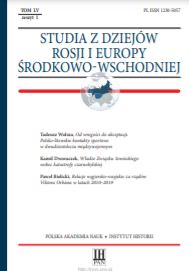Projekt konstytucji rosyjskiej z 1820 roku - tryumf czy zapowiedź końca Królestwa Polskiego?
A Draft of the Russian Constitution of 1820 - A Triumph or Foreboding of the End of the Kingdom of Poland?
Author(s): Anna BarańskaSubject(s): History of Law, Constitutional Law, 19th Century
Published by: Instytut Historii im. Tadeusza Manteuffla Polskiej Akademii Nauk
Keywords: draft of the Russian constitution of 1820; Alexander I; Kingdom of Poland 1815-1830;
Summary/Abstract: Upon his accession to the throne, Tsar Alexander I began preparing various changes in the administrative and political system of his empire. The apex of all attempts took the form of a draft of the constitution for Russia, worked up in secret in Warsaw in 1818-20 under the control of Count Nikolay Novosiltsev. The tsar approved of the ‘Constitutional Charter of the Russian Empire’, written in French and Russian, but did not attempt at implementing it. The draft of 1820 combined the solutions drawn from the Constitution of the Polish Kingdom with the federalist concept (the division of the Russian Empire into ca ten to twelve governorates, introduction of the separate central and regional administrative bodies). At the same time, it confirmed the full sovereignty of the emperor, acknowledged as the only source of power in the state. Tsar Alexander I interpreted key terms and political system ideas in a different way than their West-European authors. The political system envisioned in the 1820 ‘Constitutional Charter’ was not meant to liberalise Russia, but to modernise its administration apparatus and to free the tsar from the clutches of the court and military oligarchy in Saint Petersburg. The Polish Kingdom served as a testing ground for the planned constitution of Russia. The role of supervisor of this political experiment was played by the tsar’s plenipotentiary in Warsaw, Count Nikolay Novosiltsev. According to Tsar Alexander I’s concept, the constitution enacted in the Kingdom of Poland in 1815 was not a bilateral agreement but applied only to the citizens. It was protected against “abuse” by punitive measures proportional to its freedoms. An essential element was the simultaneous operation of two structures of power: the legal one (constitutional), and discretionary (non-constitutional). The discretionary power was superior to the legal one and was subordinated directly to Alexander I. It was represented by the governor de facto – Grand Duke Konstantin, and Novosiltsev, who were to control each other. The ultimate goal i.e. the implementation in the Russian Empire some mechanisms of the constitutional system with the preservation of autocracy explains many questions related to the political practice of the Polish Kingdom. On the other hand, the coexistence of constitutional and non-constitutional authorities in Warsaw makes it possible to understand what was expected by Tsar Alexander I after the introduction of the Constitutional Charter in his whole empire. The tsar did not plan to abolish the autonomy of the Polish Kingdom after the enactment of the Constitution in Russia. He probably considered the creation of two categories of governorates: the native Russian ones and peripheral, established according to the nationality criterion (such as Poland or Finland). The latter would preserve their separate status on the model of Hungary or Lombardy-Venetia within the Habsburg Monarchy. In the case of Poland, the problem was more complicated due to the so-called ‘Western Gubernias’ (the former lands of the Polish-Lithuanian Commonwealth annexed by the Russian Empire) and their possible incorporation into the Kingdom of Poland. The draft constitution of 1820 could not be enacted due to the total lack of social and political support.
Journal: Studia z Dziejów Rosji i Europy Środkowo-Wschodniej
- Issue Year: 55/2020
- Issue No: 1
- Page Range: 51-91
- Page Count: 41
- Language: Polish

